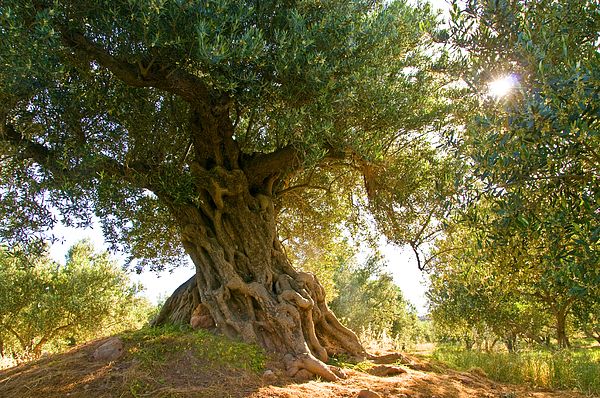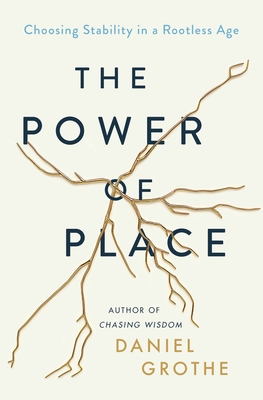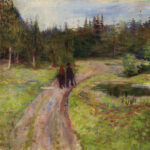Nacogdoches, TX. I was doing a workshop with clergy on being a long-term pastor when a veteran pastor friend of mine stuck his head in the door and quipped, “You know the secret to being a long-term pastor? Bad Timing. When you’re looking to move, no churches are open, and when churches are open, you’re not looking.” We all laughed; his joke cut close to the truth.
Daniel Grothe’s fine book, The Power of Place: Choosing Stability in a Rootless Age, is a testimony to a different perspective. Not bad timing but intentionally different choices have enabled Grothe to stay in one place over the long haul. Grothe’s book invites not just pastors but also laypeople – probably upperwardly mobile young adults and families – to think differently about the assumptions of job markets and moving and discipleship. In clear, concise, accessible prose, Grothe asks the reader: what if the gospel of Christ calls us to enter into a place and stick with it and stick with one another for the long haul?
Grothe begins the book with his attention-grabbing story of almost going to another job, another church in another place. After an intensive exam process with a search firm, then the church committee, including three visits to the prospective church looking at houses and schools, at the last moment, the church search committee decides to move on in another direction. Let me make an aside: if you’re a layperson in a congregation and ever have the privilege of serving on a church search committee—do not do what this committee does. Do not leave the bride/groom standing at the altar while you decide to “move on.” We pastors know about the dynamics of search committees and the difficult practice of discernment involved, but please, figure out a better way, which will likely be a harder way, of turning down a candidate than what Grothe experienced. It has not happened to me, but I know story after story of pastoral candidates in deep conversation with a search committee and then dropped like a hot potato without any explanation. We can do better; the church can do better, and one way of doing better is to remember we’re a church, not a corporation hiring management.
Let me be clear: the griping is mine, not Grothe’s. He does not tell his story to complain about the process but to tell how the prospect of almost going to another place put him in a crisis that led to discerning his vocation of putting down roots and sticking with his place. Almost leaving clarified his staying.
Grothe is enjoyable to read, winsome, and doesn’t take himself too seriously; for a preacher like me, this is highly preachable. He writes for the ear; probably the core of his chapters were originally sermons or lessons delivered to the congregation where he serves, which I’m guessing is full of people who are passing through—three or four years here before moving on to another three or four years somewhere else in service to a market economy built upon a mobile workforce. Grothe is clear and helpful about all the reasons we move on, many of which are good reasons. For example, if you’re in an abusive situation, do not stay in the abuse! At the same time, Grothe tells the reader to be aware of the assumptions of our mobile culture and notice that the gospel calls us to different assumptions. Sam Wells’s comment comes to my mind, that Jesus spent roughly thirty of his thirty-three years in one place, which might mean something about who God is and who we are called to be.
In the first half of the book, Grothe uses the stories of what he calls “saints and sages” who embody St. Benedict’s vow of stability to set out his argument, showing us how staying put changes our imagination and how we see our location, our relationships, our service, and our presence in this world. Readers accustomed to mobility are introduced to “icons of stability” like Benedict, but also Thomas Merton, Jimmy Carter, and Annie Dillard, all showing us various ways of what staying looks like. Central to all that Grothe writes is Wendell Berry, explicitly in Chapter Four—“Honoring Our Location: The Membership Benefits of Place,” which is the key chapter of the book—and implicitly influencing everything else. Berry’s presence is suffused throughout the book.
And well it should be. I once asked an editor of The Christian Century what writer he thought was most read by the readers of the magazine. He didn’t hesitate: “Wendell Berry.” I know that’s been true for me ever since I discovered Berry through a footnote in an article on rural demographics back in 1981, when I was a young new pastor of a country church. Devouring everything I could find of Berry’s, I began to figure out what Eugene Peterson later articulated:
Wendell Berry is a writer from whom I have learned much of my pastoral theology. Berry is a farmer in Kentucky. On this farm, besides plowing fields, planting crops, and working horses, he writes novels and poems and essays. The importance of place is a recurrent theme—place embraced and loved, understood, and honored. Whenever Berry writes the word ‘farm,’ I substitute ‘parish’: the sentence works for me every time. (Under the Unpredictable Plant)
In my own pastoral ministry of forty-two years, thirty-two of which has been in this same small congregation, I’ve substituted the word “church,” and like Peterson, I’ve learned that it works every time and makes for a pretty good pastoral theology. But I’ve also learned that it makes a big difference how we define “church.” If church is a corporation focused on religion or a job at a bureaucratic institution or an amalgamation of discrete individuals who gather from time to time for spiritual experience, or just another organization in town alongside the Rotary Club or the Junior Forum, then the Wendell-Berry-pastoral-theology won’t work any more than Berry’s method of farming with draft horses would work with a thousand-acre agribusiness. But if “church” is the body of Christ in its local manifestation, where each and every member is connected to one another and everyone knows each other’s names and stories, have cried together and laughed together, worshipped together, served together, prayed together, argued together, eaten together, and attended each other’s family funerals, then church becomes a place and community that is life-transformative in the manner that Grothe advocates.
Furthermore, over time, the place of church shifts. For instance, in the last part of the book, Grothe focuses on how stability is practiced in home, family, friendship, church, and the wider community, as he puts it, “in increasingly outward concentric circles.” Grothe places church toward the outer rings of the concentric circles. I suggest that church can move toward the center of the circle when more and more of us see each other as members of the body, all connected to one another in Christ. My own small congregation has heard me say many times that if someone comes into church and steps on one of our toes, I hope all of us yell in unison. I’ve been teaching this, preaching this, and practicing it in roughly the same congregation for over three decades, and I’m here to tell you that it takes work and persistence to grow discrete individuals into a unified body, and it takes constant tending over the long haul. And it is also true, to quote Berry, that “a farm can be too big for a farmer to husband properly or pay proper attention to… [and] is beyond the reach of anyone who has too much to do” (“People, Land, and Community” in Standing by Words). Being a pastor like Berry is a farmer is highly relational, and a church must be small enough for the pastor to tend it, grow it, and nurture it.
I once drove up to the Berry farm during a drought, and most every farm and garden I passed was brown and brittle from the lack of water. When I got to the Berry place, I could see their garden was lush and green. I knew they did not irrigate, so I asked, “How come your garden is green and everyone else’s is brown and dried up?” Berry said that he had been working the soil for over forty years. Forty years of composting, forty years of rotating crops, forty years of working with draft horses and not tractors so not to compact the soil, and so on. He said that after forty years of building topsoil, his topsoil was four or five feet deep, and in some places deeper, and therefore retained moisture, while his neighbors’ topsoil was closer to one or two feet deep and dried out much more quickly. So when the hard times came, his garden and topsoil were moist and resilient.
As a pastor I’m always on the lookout for aid in building congregational topsoil, and many of my church members are looking as well. Daniel Grothe’s book comes along at the right time. For the hard times are here, and we need all the help we can get.






